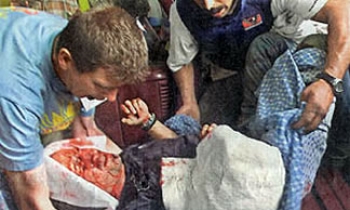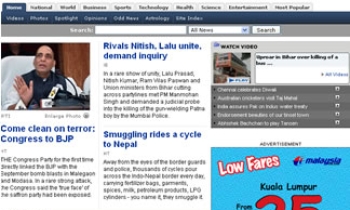Now more than ever -- when outmoded notions of "he said/she said" fairness, avaricious owners and new media all threaten newspapers' primacy -- narrative journalism has the chance and the vital mission of bringing context and emotion to reporting. Amid tips on leads, endings and everything between, that message highlighted the annual Nieman Narrative Journalism conference in Boston.
More than 950 reporters, editors, freelancers and students had their choice of 69 talks, panel discussions and nighttime sessions arranged by Mark Kramer, writer-in-residence at Harvard's Nieman Foundation for Journalism and co-sponsored by the Boston Globe, The Poynter Institute and The Oregonian.
Tom Wolfe, New Journalism's patron saint, began by calling nonfiction the one literary form that never goes out of style. "You are riding the wave of the most important writing done today," he said at a keynote session Friday afternoon. "The future is yours. Go get 'em! The time is right."
Nearly four decades ago, Wolfe famously defined New Journalism as injecting four fictional devices into conventional coverage: scenes, dialogue, status details and point of view. Now, he said, narrative journalism is sorely needed to show the "emotional side" of a story.
As an example, he cited recent articles about thieves who force homeowners to give them their valuables. He said they focus on the robberies but ignore the most compelling angle: victims' fear.
Wolfe isn't confident about newspapers' future. He said, "It would be a shame to lose print journalism, which explains why and puts things in context, but it could easily happen" as so many turn to the Internet for news.
Former Los Angeles Times editor John Carroll also praised the narrative form while worrying about the future of newspapers.
He termed narrative's attraction "eternal," from the days when primitive people sat around campfires and told stories. The genre is "never needed more than today, when we're bombarded with facts with no context," he said. "We need to gratify the reader's emotions and intelligence (to help them) make sense of the world."
But as corporate media owners cut news budgets and news holes while readership drops, Carroll said we'd "better get adjusted to a digital future."
During his five years as editor, the Times won 13 Pulitzer prizes. But he said he quit earlier this year because of an "increasingly testy relationship" with superiors and a reluctance to make further newsroom cuts "in the absence of strategy." Although he certainly doesn't embrace the vision of News Corporation owner Rupert Murdoch and his Fox executives, Carroll credits them with the "guts of a cat burglar and vision," qualities he said other chain owners lack. Instead, he charged, those corporate bigwigs see papers as mere assets of a larger corporation, and have little interest in their future.
As a major shareholder urges Knight Ridder to put itself up for sale or sell some of its 32 papers, Carroll said he's not sure who the "good guys" are, because, he said, the news company has been slowly "diminishing" its papers with staff cuts. He said breaking up the chain and selling papers to local owners would be the best outcome.
Narrative shouldn't be confined to massive enterprises, he continued. "Any story should surprise and delight" –- even a short police report.
FAIRNESS DOCTRINES
As critics from all sides of the political spectrum allege journalistic bias, panelists tackled the eternal question of how to be fair.
Cheryl Carpenter, managing editor of the Charlotte Observer, said narrative reporters shouldn't be seduced by their extraordinary access to their subjects. "Think of narrative journalism as a way you get at the messiness of truth" and you'll be fair to both readers and subjects.
Mark Singer, New Yorker staff writer, said, "My fundamental sympathy is sufficient protection against the subject feeling ripped off." To him, and several other speakers, fairness means not lying, not misrepresenting yourself, and clarifying on- and off-the-record ground rules. He tries to get people doing something they're passionate about, not just in the "static place" of the formal interview, but will leave the room if they want to talk to someone else confidentially.
Gerald M. Boyd, former New York Times managing editor, bemoaned what he called the increasing tendency for reporters to tell subjects, " 'If you play ball and give me access, you'll get better treatment' ... We should feel passionate about fairness and not get caught up in the issues of access and cooperation."
Orville Schell, dean of the University of California, Berkeley, Graduate School of Journalism, said, "Fairness is not a place on the 50-yard line, the middle between a lie and the truth ... You have to have a very strong compass, and let the story unfold to readers the same way it unfolds to you."
Philip Gourevitch, Paris Review editor and New Yorker staff writer, said suspending judgment about your subject is "a bad notion, and a way to avoid seeing reality ... (While) we bend over backward to find someone who backs a bogus claim, people are turning away from newspapers because they don't tell (them) what it all comes down to."
Gourevitch was one of several speakers charging the press with being too defensive in the face of increasing political attacks. He sees "broad incuriosity about pushing stories beyond where they're supposed to go," saying "politicians are more sophisticated about how to work the press than the press is sophisticated about pushing back." He said journalists follow politicians' agendas too closely, and depend on the opposing party to tell the "other side" when the real two sides are "true" and "not true."
CULLS, LEADS, NUTS AND ENDINGS
Many conference sessions focused on the nuts and bolts of culling compelling stories from reams of material.
Kramer was one of several speakers who recommended taking "lavish notes" and interviewing as little and as late as possible. "The more you just watch, the more you fade into the background," the more intimate details you'll get, he said. To help decide your central theme, think of your "destination." After you "scoop up everything," read your mass of notes to someone to identify the most interesting material.
Adam Hochschild, the co-founder of Mother Jones magazine whose latest book is, "Bury the Chains," also favors editing by conversation. "We're all quite good editors of ourselves as talkers" because we're aware of our listener's time constraints and attention span. So "as you tell someone what you think the story is, you'll see the structure as you talk."
Hochschild and others said a clear idea of beginning and ending scenes helps them sort out research. He tries to come back from every assignment with two or three characters, and two or three scenes, including dialogue, setting and action.
"Listen to your material," he advised. "It might steer you in a very different direction" than to the story you envisioned.
A master at being steered by material is Jacqui Banaszynski, a Pulitzer Prize-winning feature writer who now teaches at the Missouri School of Journalism. She tries to "turn subjects into story tellers," even in phone interviews, by asking them, "What's in the room? What are you wearing?"
An interview should not be a Q&A, she insists. Get subjects "out of the box of the predictable (and) ask them a non-traditional layer of questions." For example, she asked an AIDS patient, "What did the nurse say?" and "What was your first reaction?" as she broke the grim news.
She urged writers to pick the "revelatory detail." In one case, this was the hands of a surgeon performing delicate facial reconstruction on a young girl. Before cutting, he braided her hair -– a gesture that takes readers as close to the story as the reporter was.
Banaszynski warned against leading with your most accessible interviewee, the one who gives you the most time. "Don't go for the easy, dramatic lead if it's not the heart of the story ... A lead is a contract, my promise to the reader and I have to deliver."
"Don't think about how you write, but about how you read," she said. Her own test is her mother: if Mom isn't hooked by the eighth paragraph, she'll quit. So weave "nut graph" information throughout the story, giving information and statistics after you've got the reader. Instead of traditional definitions of direct and indirect leads, she likes to think in these terms: one kind tells you the news, and another the story.
IMMERSION JOURNALISM
Newark, N.J., Star-Ledger feature writer Robin Gaby Fisher, a two-time Pulitzer finalist, suggested that immersion journalism is narrative taken to its highest power. "Narrative is the private story behind the public story, and it takes time to get that." Spending every waking hour for nine months watching two burn victims fight for physical and emotional survival was "stressful, emotional but so incredibly rewarding." Choking up as she detailed their struggle, Fisher shares her own struggles with her subjects. "Give up yourself, because you ask so much of people."
She thinks too many reporters flaunt their own importance to, and "talk over," their subjects. Instead, "Be quiet, listen, let things unfold, and you'll get remarkable stuff."
Fisher believes, "You can become a great writer -– or at least tell great stories -– through immersion ... Don't just parachute in, hang out and expect them to open their hearts to you. It's being there, being a reporter –- a reporter, not a writer ... If you can get in (subjects') heads, you're home."
Practice immersion with "day in the life" profiles, she said. "You can teach yourself, and if you're passionate (about in-depth reportage) your editors will be passionate with you."
Baltimore Sun health reporter Diana K. Sugg delivered a similar message.
"I won the Pulitzer (in 2003, for beat reporting) because I did the stories that really matter to me ... Too often, we ignore the stories (we) really want to do, that nag at you, that you talk to others about. (But) the questions that haunt you are haunting a hell of a lot of other people."
Pursuing delicate end-of-life stories has led her to crack houses and a glare that made her feel like "scum." But she persevered. "You can go much further than you think. You have to go the distance (amid) rejection. The best stories have no deadlines. You can get any story you want if you just keep going. Too often we give up. There's buried treasure on your beat and in your heart. Don't let the cynics get to you; you have to be your own champion."
Tom French, the Pulitzer-winning St. Petersburg Times serial narrative specialist, offered many tips for immersion reporting, including these:
- When deciding whom to follow, "look for texture, vulnerability, contradiction, a clear line of action that will engage the reader and reveal character and theme."
- Zoom in. Find a simple frame. Follow one love struck teen, not the whole seventh grade.
- Get the details: the dog's name, the song title, the brand of the beer.
- Keep asking: for their diary, for the contents of their purse. "Never assume your subject will say no. Time and again, you'll find that people are more generous and brave than you would imagine."









